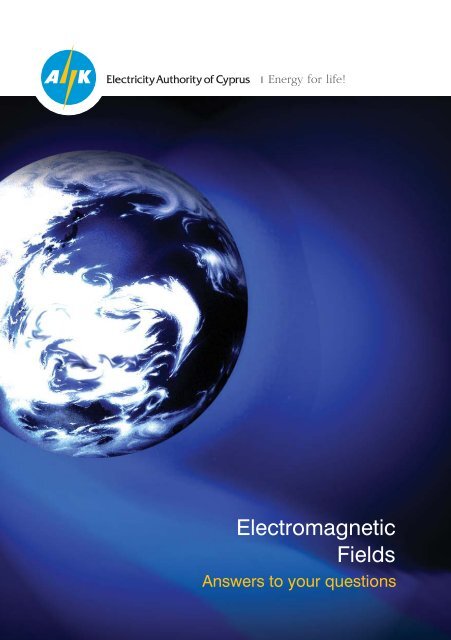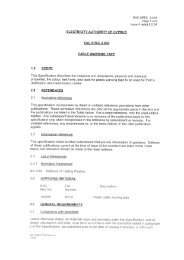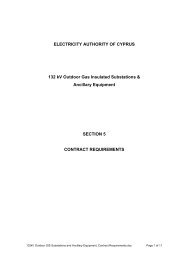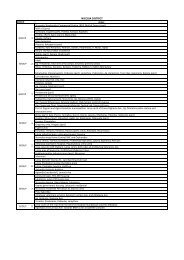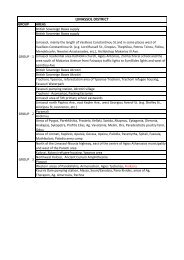Electromagnetic Fields
Electromagnetic Fields
Electromagnetic Fields
You also want an ePaper? Increase the reach of your titles
YUMPU automatically turns print PDFs into web optimized ePapers that Google loves.
<strong>Electromagnetic</strong><br />
<strong>Fields</strong><br />
Answers to your questions
Introduction<br />
A number of epidemiological studies that have been carried out in recent years<br />
have speculated about the existence of a direct relationship between<br />
electromagnetic fields and health problems. However, no study to date has<br />
succeeded in proving such a relationship.<br />
The subject has been studied by teams of scientists in a variety of specialist<br />
areas from many international organizations and all have concluded that,<br />
based on the epidemiological studies and experimental evidence obtained<br />
so far, there is no serious evidence to link 50-60Hz electromagnetic fields<br />
with any disease.<br />
By providing the following information, EAC wishes to report on what is<br />
actually known to date and to place the subject in its true context, so as to<br />
avoid wrong impressions and unjustified concerns on the part of the public.
What are Electric and Magnetic <strong>Fields</strong><br />
An electric field is generated by the pressure (voltage), or the electrical force<br />
caused by the flow of electricity through a conductor (device, line, cable). This field<br />
has a unit of measure volt per metre (V/m).<br />
A magnetic field is generated by the intensity of the electric current as it flows<br />
through the conductor. This field is measured in Teslas (T) or fractions of Tesla,<br />
such as a microtesla (ÌT) which is a million times smaller than a Tesla.<br />
An electric field increases in intensity according to the voltage that generates it and<br />
a magnetic field grows in size as the current increases.<br />
What are <strong>Electromagnetic</strong> <strong>Fields</strong><br />
Electricity flowing through a conductor generates two fields: an electric field and a<br />
magnetic field.<br />
<strong>Electromagnetic</strong> fields are generated by power lines (Transmission & Distribution)<br />
and by any other electricity conductor, electric machine or electrical appliance,<br />
such as a hair dryer, a house’s wiring system, a computer, etc.<br />
<strong>Electromagnetic</strong> fields are also generated by radio and television transmission<br />
masts and by mobile telephony masts. These fields are high frequency (up to 300<br />
GHz) and have different properties from the low frequency (50-60 Hz) fields created<br />
by the electrical systems operated by power companies such as EAC.<br />
Another electromagnetic field, which exists everywhere, is the one created by the<br />
Earth’s natural magnetism (Earth’s magnetic field) and other natural phenomena.<br />
The size of the magnetic field on the Earth’s surface depends on the geographical<br />
latitude and varies between 30 mΔ and 70 mΔ approximately.<br />
The Earth’s electric field is about 120 V/m close to the surface. The intensity of the<br />
electric field is affected by weather conditions and other natural phenomena.<br />
<strong>Electromagnetic</strong> fields cannot be seen or felt but they can be measured with the<br />
use of special equipment. Their size depends on the magnitute of voltage or<br />
intensity of the electric current flowing through the conductor.<br />
<strong>Electromagnetic</strong> fields are substantially reduced, at a fast rate, by moving away<br />
from the source that generates them (increasing or descreasing depending on the<br />
distance from the source that generates them).
Where do electromagnetic fields exist<br />
<strong>Electromagnetic</strong> fields exist everywhere in nature and usually comprise a mixture<br />
of fields such as the Earth’s electric and magnetic fields together with those<br />
generated wherever electricity is used. They exist in every house that uses electrical<br />
appliances, close to power lines, near radio and television station masts, mobile<br />
telephony masts and similar installations.<br />
The magnetic fields generated by some domestic electrical appliances are much<br />
larger than those generated by power lines, as shown in the table below.<br />
Magnetic fields in the proximity of various domestic<br />
appliances<br />
DOMESTIC APPLIANCE SIZE OF MAGNETIC FIELD (ÌT) AT DIFFERENT DISTANCES<br />
3 cm 30 cm 1 m<br />
Hair dryer 6 - 2000 less than 0,01 - 7 less than 0,01 - 0,3<br />
Electric shaver 15 - 1500 0,08 - 9 less than 0,01 - 0,3<br />
Electric saw 250 - 1000 1 - 25 0,01 - 1<br />
Electric Drill 400 - 800 2 - 3,5 0,08 - 0,2<br />
Vacuum cleaner 200 - 800 2 - 20 0,13 - 2<br />
Mixer 60 - 700 0,6 - 10 0,02 - 0,25<br />
Fluorescent desk lamp 40 - 400 0,5 - 2 0,02 - 0,25<br />
Microwave oven 75 - 200 4 - 8 0,25 - 0,6<br />
Fluorescent light 15 - 200 0,2 - 4 0,01 - 0,03<br />
Electric cooker plate 6 - 200 0,35 - 4 0,01 - 0,1<br />
Television 2,5 - 50 0,04 - 2 less than 0,01 - 0,15<br />
Electric oven 1 - 50 0,15 - 0,5 0,01 - 0,04<br />
Washing machine 0,8 - 50 0,15 - 3 0,01 - 0,15<br />
Electric iron 8 - 30 0,12 - 0,3 0,01 - 0,25<br />
Fan – Blower 2 - 30 0,03 - 4 0,01 - 0,35<br />
Dishwasher 3,5 - 20 0,6 - 3 0,07 - 0,3<br />
Refrigerator 0,5 - 1,7 0,01 - 0,25 less than 0,01<br />
TYPICAL FIELD FOR A DOMESTIC ENVIRONMENT: 0,01 - 0,2 ÌT<br />
FIELD DIRECTLY BENEATH OVERHEAD 132 kV POWER LINES IN CYPRUS: 0,5 - 7 ÌT<br />
ACCEPTED LIMIT FOR CONTINUOUS HUMAN EXPOSURE TO 50 Hz MAGNETIC FIELD: 100 ÌT<br />
The above limit, concerning the 50Hz frequency on which the EAC’s systems operate, was set by the Council of<br />
Europe.
Conclusions of International Organizations<br />
"Based on the epidemiological studies and laboratory research carried out so far,<br />
there is no definitive evidence associating electromagnetic fields with any disease."<br />
In summary, this is the scientists’ conclusion on the subject, as announced at the<br />
end of a meeting of the three most authoritative and internationally renowned<br />
organizations – the Edison Electric Institute (EEI) of the USA, the Federation of<br />
Electric Power Companies of Japan (FEPC) and the International Union of<br />
Producers and Distributors of Electrical Energy (UNIPEDE) – which was held in<br />
Washington on May 11-12, 1993. The above statement was reaffirmed by the three<br />
organizations in May 1994.<br />
Other prestigious international organizations argue:<br />
"There is no persuasive biological evidence to show that low level low-frequency<br />
electromagnetic fields can influence any of the accepted stages in carcinogenesis"<br />
Documents of NRPB, Vol.5, No.2, 1994<br />
(National Radiological Protection Board, UK)<br />
"A detailed review of the studies on the possible biological effects of<br />
electromagnetic fields has failed to confirm them as a cause of cancer. The<br />
review… examined 245 papers recently published around the world but found no<br />
evidence to justify the high level of media speculation concerning the possible<br />
harmful effects of low-frequency electromagnetic fields or the needless public<br />
concern it generates."<br />
Institution of Electrical Engineers,<br />
UK (Review 1994)<br />
"The scientific literature and the reports of reviews by other panels show no<br />
consistent, significant link between cancer and power line fields… No plausible<br />
biophysical mechanisms for the systematic initiation or promotion of cancer by<br />
these power line fields have been identified. Furthermore, the preponderance of<br />
the epidemiological and biophysical/biological research findings have failed to<br />
substantiate those studies which have reported specific adverse health effects<br />
from exposure to such fields."<br />
American Physical Society Washington<br />
(Council Statement 1995)<br />
"The conclusion of the committee is that the current body of evidence does not<br />
show that exposure to these fields presents a human health hazard" and<br />
"Specifically, no conclusive or consistent evidence shows that exposures to<br />
residential electric or magnetic fields produce cancer, adverse neurobehavioral<br />
effects, or reproductive and developmental effects."<br />
U.S. Academy of Sciences<br />
(Report 1996)
"<strong>Electromagnetic</strong> fields have not been shown to cause cancer. In fact, no nonionizing<br />
radiation has been shown to cause cancer or to promote its growth once<br />
it has started."<br />
American Cancer Society<br />
(Document 002689, 1997)<br />
"The results of the research… provide substantial evidence that there is not a robust<br />
biological effect of EMF exposure at environmentally relevant levels. These data<br />
when taken together with the National Academy of Sciences report provide a basis<br />
for concluding that environmental EMF exposures at the levels to which human<br />
exposure occurs in the environment do not demonstrate an effect on critical<br />
biological processes and functions that could be expected to adversely affect<br />
human health…"<br />
National Institute of Environmental Health Sciences (NIEHS),<br />
USA (From the summary of the of the results of research supported by the NIEHS, December<br />
14, 1998)<br />
The NIEHS places the possible danger from low frequency electromagnetic fields<br />
in the same category as coffee, vehicle exhaust fumes, saccharin, etc., based<br />
on the evaluations of carcinogenic factors of the International Agency for Research<br />
on Cancer (IARC).<br />
"There is no proven link between EMFs and childhood or adult cancer and no<br />
additional scientific evidence which would call for a change in exposure<br />
guidelines."<br />
National Radiological Protection Board,<br />
UK (NRPB Report on <strong>Electromagnetic</strong> fields and the Risk of Cancer, 2001)<br />
The above conclusion was also reached by the Scientific Committee on Toxicity,<br />
Ecotoxicity and the Environment (CSTEE) of the European Commission, following<br />
the relevant directive of the Directorate General, Health and Consumer Protection<br />
of the European Commission.<br />
Directorate General, Health and Consumer Protection<br />
EAC action<br />
The EAC has an extremely well-informed technical staff, members of which are<br />
continuously monitoring and being briefed on the latest developments through<br />
official organizations, specialist publications and their own studies that are<br />
published from time to time. The EAC assures the public that it has adopted and<br />
complies with the accepted limits on electromagnetic field exposure that have been<br />
set by internationally approved organizations as a preventative measure, and that<br />
it will take any measures that may be decided by such organizations in the future.<br />
Cyprus is a relatively small country and does not possess the necessary<br />
mechanisms to take its own decisions on such an issue concerning human health.
The EAC has acquired special equipment and carries out measurements of Electric<br />
and Magnetic fields created by power lines. The results of these measurements so<br />
far have shown that the strength of the fields is extremely low compared with the<br />
maximum acceptable limits set by international organizations such as the World<br />
Health Organization WHO), the International Radiation Protection Association<br />
(IRPA) and the European Committee for Electrotechnical Standardization<br />
(CENELEC).<br />
Exposure limits for electromagnetic fields<br />
The Electricity Authority has adopted fully all the relevant recommendations and<br />
directives of the European Union which determine the strictest limits among those<br />
of the above mentioned international organizations.<br />
Concerning exposure to electromagnetic fields, the population can be divided into<br />
two categories: the general population and the working population.<br />
Regarding the general population, the Electricity Authority has adopted fully and<br />
complies with the Recommendation of the European Council 1999/519/EC of July<br />
12, 1999 on the limitation of exposure of the general public to electromagnetic<br />
fields (0Hz-300GHz). On the basis of this recommendation, the acceptable limit for<br />
the 50Hz frequency on which the Electricity Authority’s network operates is 100ÌT<br />
for the magnetic field and 5,000V/m for the electric field.<br />
Regarding the working population, the Electricity Authority has adopted fully and<br />
complies with the Directive 2004/40/EC of the European Parliament and Council of<br />
April 29, 2004 on the minimum health and safety requirements regarding the<br />
exposure of workers to the risks arising from physical agents (electromagnetic<br />
fields). On the basis of this Directive, the limit applicable to the 50Hz frequency is<br />
500ÌT for the magnetic field and 10,000V/m for the electric field.<br />
The average magnetic field that is created directly beneath the Authority’s 132 kV<br />
power lines fluctuates between 0.5ÌT and 7ÌT. In other words, it is between 14 and<br />
200 times lower than the 100mΔ limit set by the European Council. It is very<br />
important to state that magnetic fields of this size exist inside every household,<br />
office, etc. The average electric field fluctuates between 40V/m and 1,000V/m, i.e.<br />
5 to 125 times lower than the Council of Europe’s 5,000V/m limit.
PO Box 24506 CY-1399 Lefkosia<br />
Tel: +357-22201000 Fax: +357-22201020<br />
Email: eac@eac.com.cy Website: www.eac.com.cy<br />
12/2005


